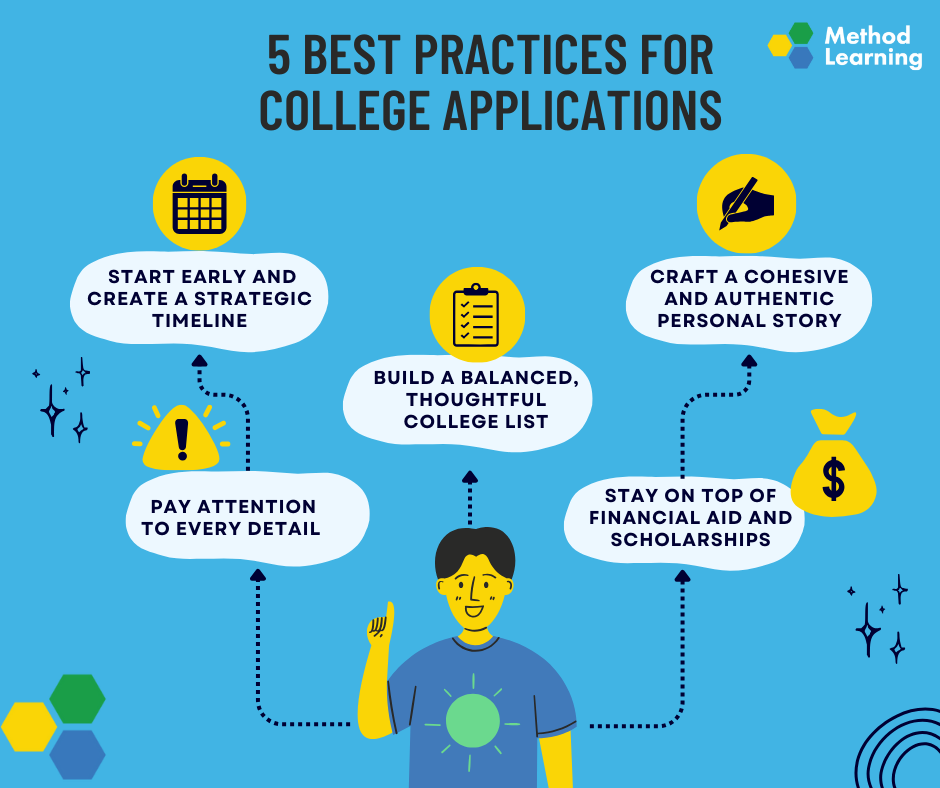5 Best Practices to Master Your College Applications and Stand Out
.png)
Applying to college can be one of the most exciting—and overwhelming—milestones in a student’s life. It’s a time filled with possibilities, choices, and dreams about the future, but it also comes with its fair share of pressure. Between standardized tests, crafting personal essays, requesting recommendation letters, preparing for interviews, and navigating financial aid forms, the sheer number of tasks can feel daunting. It’s easy to wonder where to start or how to keep everything on track.
The good news? You don’t have to tackle it all at once, and you don’t have to do it alone. When you break the college application process down into clear, manageable steps and stay organized along the way, it becomes far less stressful—and a lot more empowering. With the right mindset, strategy, and structure, applying to college becomes an opportunity not just to gain acceptance to a school, but to discover more about yourself and your goals.
Whether you are just beginning to explore your college options or you’re deep into essay drafts and application deadlines, understanding and applying these best practices will help you stay focused, reduce stress, and submit applications that are not only complete—but compelling and authentic. Ready to get started? Let’s dive into the five best practices that will set you up for success.

1. Start Early and Create a Strategic Timeline
One of the biggest mistakes students make is waiting too long to start the college planning process. The earlier you begin, the better positioned you’ll be to make thoughtful, well-researched decisions rather than rushed ones. Ideally, serious planning should begin during junior year—or even late sophomore year for highly competitive applicants.
Create a month-by-month timeline that outlines important milestones: standardized testing dates, college visits, essay brainstorming and drafts, recommendation letter requests, application deadlines (Early Action, Early Decision, Regular Decision), and financial aid submission dates. Breaking the journey into smaller tasks makes it feel much more manageable. Plus, early preparation allows you to take advantage of opportunities like scholarship programs or early application options that you might otherwise miss if you're scrambling at the last minute.
Pro Tip: Use a digital calendar or planning tool like Google Calendar, Trello, or Notion. Color-code your tasks by type—testing, essays, applications, scholarships—and set multiple reminders for each deadline. Staying consistently ahead reduces stress and gives you room to navigate unexpected challenges.
2. Build a Balanced, Thoughtful College List
Your college list should reflect your academic, social, and financial goals—not just the prestige of a school's name. A thoughtful, balanced list usually includes about 8–12 schools divided among reach schools (aspirational), match schools (solid fit), and likely (safety) schools where you’re confident about admission.
When researching colleges, dig deeper than brochures or rankings. Ask yourself:
-
Does the college offer strong programs in my areas of interest?
-
What is the campus culture like—collaborative, competitive, artistic, entrepreneurial?
-
Are there strong support services such as tutoring, advising, or mental health resources?
-
How accessible are financial aid, scholarships, and work-study opportunities?
-
Is the location and size of the campus a good fit for my lifestyle?
Building a balanced list ensures that you have options no matter how the admissions cycle turns out. It also reduces unnecessary pressure and gives you a range of environments where you can thrive.
Pro Tip: Use platforms like College Board’s BigFuture, CounselMore, and Niche to compare colleges side-by-side. Also, research each school’s Common Data Set to better understand what they prioritize—this will help you tailor your application for a stronger fit.
3. Craft a Cohesive and Authentic Personal Story
Colleges are looking for more than just strong grades and test scores—they’re looking for students who will bring curiosity, passion, and resilience to their campus. Your application is your opportunity to tell a story about who you are, what drives you, and what you value.
Every part of your application—from your activities list to your essays and recommendation letters—should work together to paint a cohesive picture. Think deeply about your experiences: What have been your biggest challenges? Your proudest moments? What lessons have you learned? How have these experiences shaped your goals and character?
Rather than trying to fit into a perceived mold, focus on being genuine. The strongest applications highlight unique traits and perspectives. Show how you’ve made an impact, how you’ve grown, and what you hope to contribute to a future campus community.
Pro Tip: Before you start writing, brainstorm a few key themes or traits—such as leadership, creativity, resilience, or a love of learning—that you want admissions officers to take away from your application. Weave these consistently through your essays, activities, and interviews to build a memorable personal brand.
4. Pay Attention to Every Detail
In college admissions, small details matter. Admissions officers read thousands of applications each year, and while mistakes are understandable, they can also be distracting—and sometimes costly. A misspelled college name, a missed supplement, or incorrect formatting can create a negative impression or even lead to an incomplete application.
Proofread every element of your application thoroughly. Double-check that you’ve answered all essay prompts correctly, listed activities in order of importance, and uploaded the right documents. Make sure your recommender forms, transcripts, and test scores are sent and received on time. Confirm your application fee payment or request a waiver if needed.
Setting internal deadlines—several days or even a week before the official deadline—gives you critical breathing room to review and polish your materials. Rushing to submit at the last minute often leads to avoidable mistakes.
Pro Tip: Read your essays and short answers out loud. Hearing your words helps you catch awkward phrasing, missing words, or typos. Also, have a trusted adult—parent, counselor, or teacher—review your application with fresh eyes. Their perspective can catch things you might miss after so much close work.
5. Stay on Top of Financial Aid and Scholarships
The cost of college is a major factor for most families, and financial aid planning should happen alongside your application process—not afterward. Financial aid can significantly expand your options, but only if you complete all necessary forms correctly and on time.
Start by submitting the FAFSA (Free Application for Federal Student Aid) as soon as it opens, typically October 1. If your colleges require it, complete the CSS Profile as well. These forms determine your eligibility for grants, loans, and institutional aid.
Beyond basic financial aid, research merit scholarships and local awards early. Many scholarships have fall or early winter deadlines that can easily be missed if you’re only focused on applications.
Also, keep a separate calendar or spreadsheet solely for financial aid tasks—FAFSA deadlines, scholarship applications, priority financial aid dates for each college, and external scholarship deadlines. Some aid is awarded on a first-come, first-served basis, meaning early action can make a major difference in the amount of aid you receive.
Pro Tip: Explore free databases like Fastweb, Going Merry, or ScholarshipOwl to find external scholarships. Apply widely—smaller awards can add up and cover unexpected costs like textbooks, fees, or travel expenses.
Final Thoughts: Progress Over Perfection
The college application process can be challenging, but it’s also an incredible opportunity for self-reflection and growth. It’s not about crafting a perfect application—it’s about telling your story with honesty, care, and pride. Every step you take—whether drafting essays, researching colleges, or meeting deadlines—brings you closer to shaping your future.
Stay organized, stay true to who you are, and trust that the right opportunities will open up through your hard work and persistence. College admissions is not a race against others; it’s a journey toward finding the environment where you will thrive, contribute, and continue becoming the best version of yourself.

